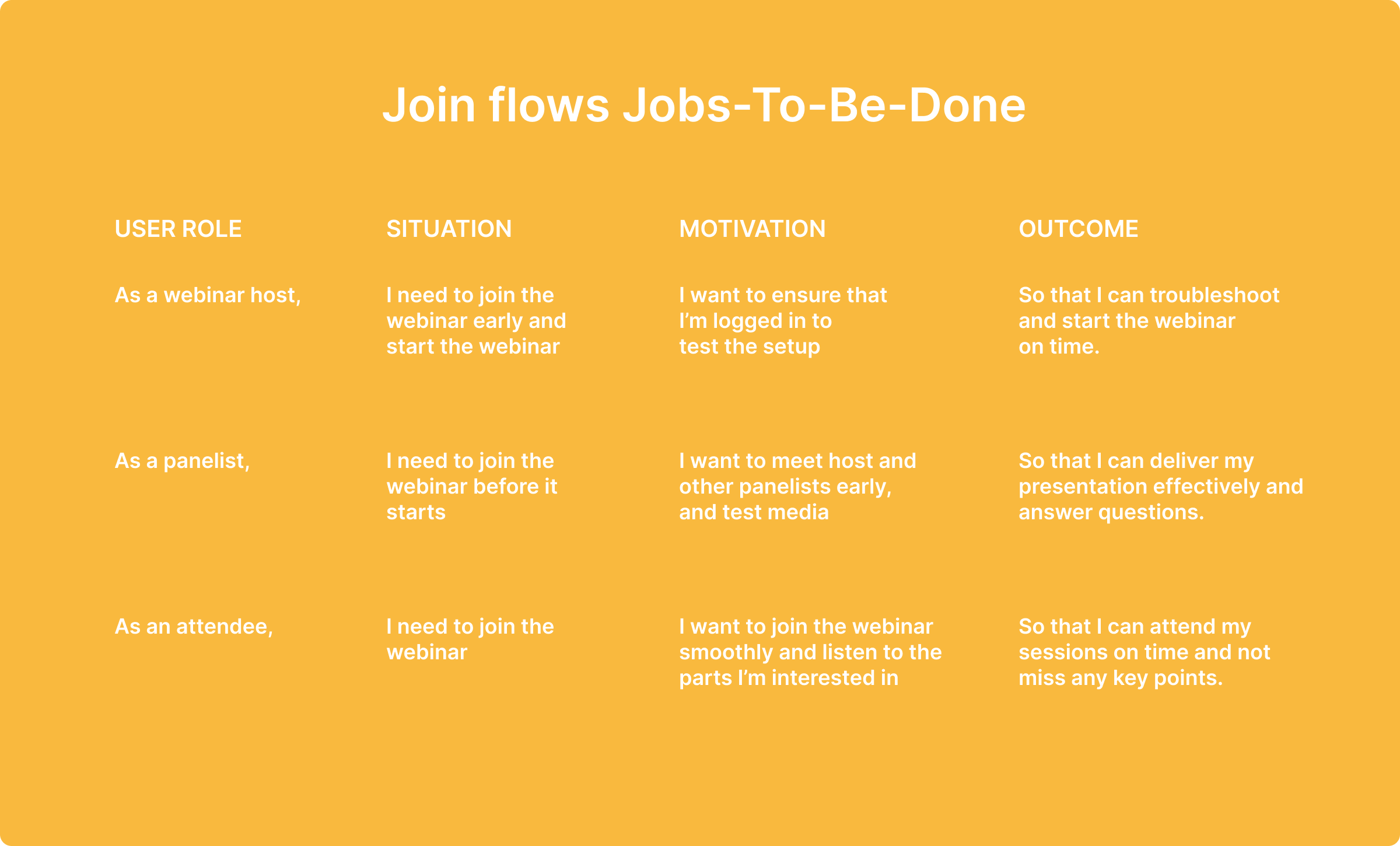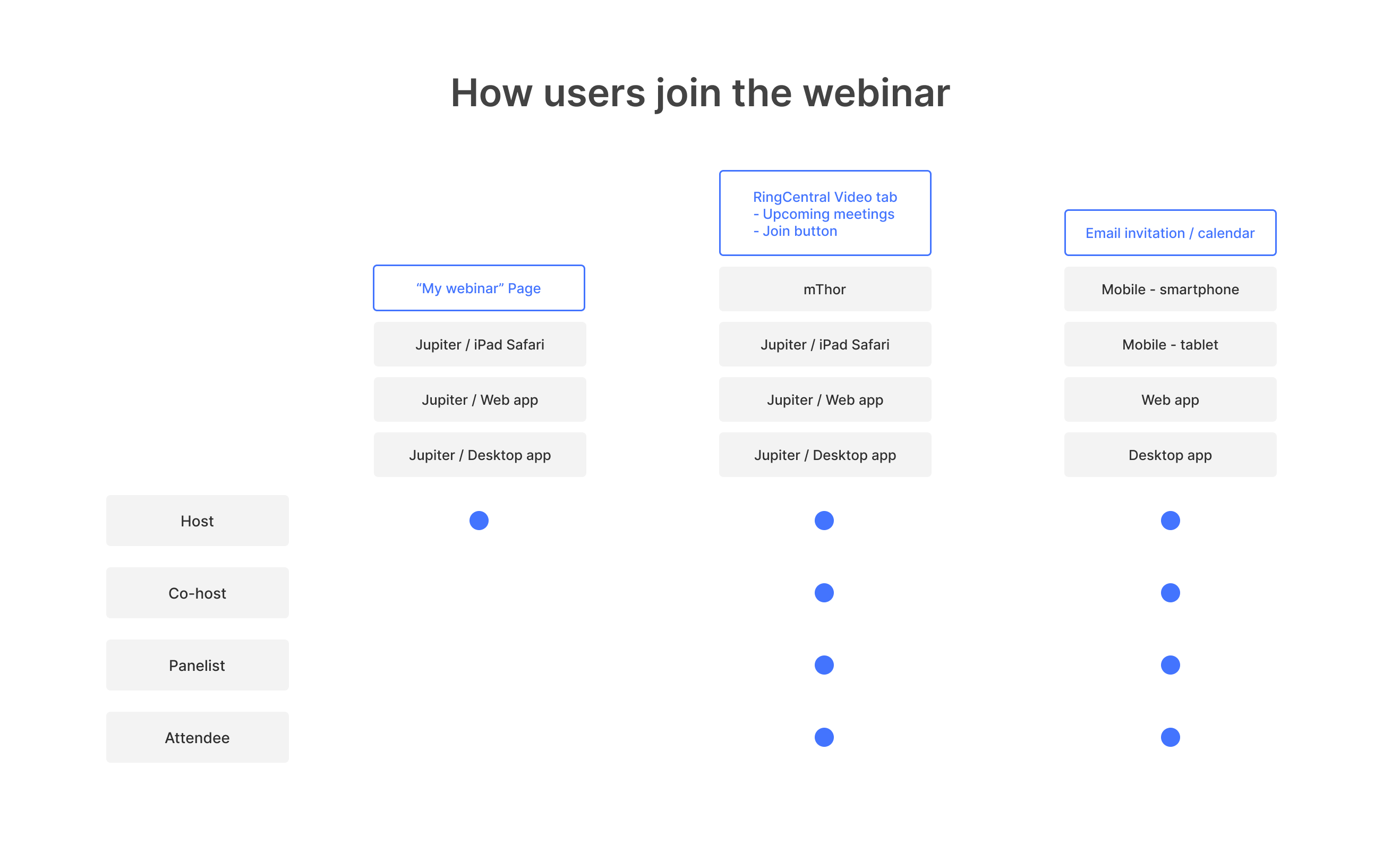The Problem Statement and
the challenges
How might we provide a seamless join-and-leave webinar experience for hosts, co-hosts, panelists, and attendees across different conditions and platforms?

My contribution
As the lead designer for this project, I designed the RingCentral Webinar's join flows from scratch for various user roles on multiple platforms, led design reviews with cross-functional stakeholders, negotiated project priorities with PMs under tight timelines, and strategized a more efficient design review process with PMs and engineers to ensure project success.
Lead Designer
1 senior product manager (Dipkin), UX Writer (Anastasia) & Engineering (Mario L.+)
3 Months
The Problem Statement and
the challenges

The impacts


From a business perspective, our initial goal was to migrate current customers from Zoom to our in-house RingCentral software as quickly as possible to save costs. After the research team conducted a comprehensive competitor study to understand the current webinar products on the market, we realized that it would take at least 1.5 years to achieve our planned product scale. However, this timeline was not acceptable from a business standpoint, as our contracts with Zoom were nearing expiration. Therefore, an aggressive launch plan was scheduled.
Our goal was to launch the webinar product within 9 months. When I joined to assist with the webinar features, there were only two designers on the webinar's team, and I had just 3 months remaining before the initial planned release date for RingCentral customers. As a result, I had to work quickly, creating precise design plans and executing them within the remaining three months to ensure that our users would have a frictionless join-and-leave experience in our MVP webinar product.


To understand webinars, it’s useful to start by looking at meetings. One of the most common misconceptions is that webinars are just larger meetings, but they’re actually quite different.
After the UX research team spent a couple of weeks examining existing webinar solutions in the market, we realized that webinars represent a much larger and more complex space than RingCentral’s meeting products, where I had previously delivered major features before joining the webinar project.
A robust webinar platform must include several key features to meet user needs across the entire webinar lifecycle. Below are the essential components a mature webinar product must have to address these user needs.

In the image below, I categorized various user roles in webinars according to their levels of control within the webinar rooms. In a webinar environment, hosts and co-hosts hold highest level of control, managing everything from the presentation flow to participant settings. Panelists are invited speakers who add value by sharing content and engaging in discussions without full admin control. Finally, attendees are the audience members who primarily observe the presentation with limited controls, can participate in Q&A or chat as needed.

To enhance collaboration efficiency with stakeholders, I mapped out the join flow for each user role—host, co-host, panelist, and participant—using flowcharts to facilitate easier review and feedback.
To provide some background, the RingCentral app is a comprehensive ecosystem with cross-platform capabilities, allowing users to join webinars from multiple entry points, including Jupiter (RingCentral desktop app), mThor (RingCentral mobile app), and RingCentral web app on both desktop and mobile platforms.

Below are the flowcharts I shared with PMs and engineers during the design review process. Through this flowcharts prototype, stakeholders are able to quickly glance through the flow in each use case and provide timely feedback.


In the three months following my involvement in the project, the new webinar feature was successfully launched as an external beta version for RingCentral customers on both desktop and mobile platforms, ahead of Zoom’s contract deadline. This achievement enabled the company to save $5.1 million annually by transitioning customers from Zoom’s platform to RingCentral’s in-house webinar solution.
This realese allowed the RingCentral webinar reached general availability (GA) globally, introducing advanced features tailored for marketing and all-hands webinars. These included branded registration pages, automated emails, and seamless integration with tools like Adobe Marketo.
